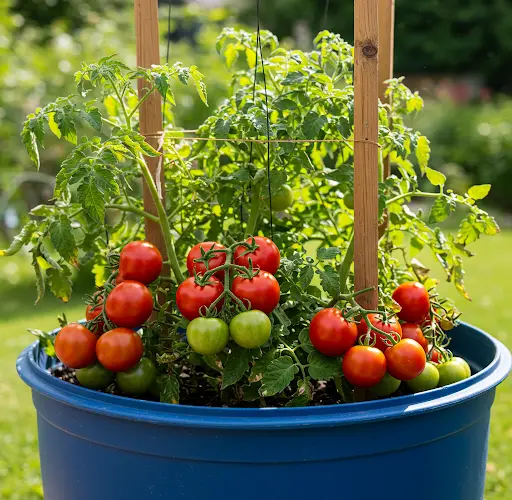How to Grow Tomatoes in a Plastic Barrel: The Ultimate Guide
Tomatoes are one of the most popular and rewarding crops to grow, and using a plastic barrel as a planter is an excellent method for maximizing space and improving yields. This technique is particularly useful for those with limited garden space, poor soil conditions, or a desire to recycle materials into sustainable gardening solutions. With the right approach, you can produce large, succulent, and juicy tomatoes from the convenience of a plastic barrel.
In this guide, we’ll take you step by step through growing tomatoes in a plastic barrel, from preparation to harvest, ensuring healthy plants and a bountiful crop.
Why Grow Tomatoes in a Plastic Barrel?
Using a plastic barrel for tomato cultivation offers several advantages:
✅ Space-Saving – Perfect for small gardens, patios, or balconies. ✅ Recycling Friendly – Reuses old plastic barrels instead of discarding them. ✅ Excellent Drainage Control – Prevents overwatering and root rot. ✅ Pest Protection – Elevates plants, reducing exposure to soil-borne pests. ✅ Extended Growing Season – Barrels can retain warmth, encouraging faster growth.
Materials Needed
To get started, you will need the following materials:
- A large plastic barrel (55-gallon or 30-gallon works best)
- Drill or sharp knife (for drainage holes)
- High-quality potting mix
- Organic compost or aged manure
- Tomato seedlings or seeds
- Slow-release fertilizer
- Mulch (straw, dry leaves, or wood chips)
- Watering can or drip irrigation system
- Wooden stakes or tomato cages (for plant support)
Step-by-Step Guide to Growing Tomatoes in a Plastic Barrel
Step 1: Preparing the Plastic Barrel
- Clean the Barrel – If using a recycled barrel, wash it thoroughly to remove any chemical residues.
- Create Drainage Holes – Drill several holes at the bottom and lower sides of the barrel to prevent waterlogging.
- Cut Open the Top – If the barrel has a sealed top, cut out a wide opening to allow easy planting and watering.
- Optional: Side Openings – Some gardeners cut small holes along the barrel’s sides to grow multiple tomato plants in a vertical system.
Step 2: Choosing the Right Tomato Variety
Certain tomato varieties thrive better in container gardening. The best options include:
🍅 Cherry Tomatoes – Small, fast-growing, and high-yielding. 🍅 Roma Tomatoes – Meaty, great for sauces and paste. 🍅 Beefsteak Tomatoes – Large and juicy, perfect for slicing. 🍅 Determinate Varieties – Bush tomatoes that grow compactly and are ideal for containers. 🍅 Indeterminate Varieties – Vining tomatoes that need support and continuous pruning.
Step 3: Preparing the Soil Mix
Tomatoes need nutrient-rich, well-draining soil for healthy growth. Follow this mix:
🌱 50% Potting Soil – Provides a light, airy structure. 🌱 30% Compost or Aged Manure – Boosts organic matter and nutrients. 🌱 10% Perlite or Sand – Improves drainage. 🌱 10% Worm Castings or Organic Fertilizer – Enhances soil fertility.
Mix these ingredients well before filling the barrel.
Step 4: Planting the Tomato Seedlings
1️⃣ Fill the Barrel – Leave about 6 inches of space at the top. 2️⃣ Dig a Deep Hole – Tomatoes grow better when their stems are buried deeply (remove the lower leaves before planting). 3️⃣ Plant the Seedlings – Place them in the holes and cover them with soil. 4️⃣ Water Thoroughly – Hydrate the plant well to reduce transplant shock.
Caring for Your Tomatoes
1. Watering
💧 Consistent Moisture – Tomatoes need 1-2 inches of water per week. Keep the soil moist but not soggy. ⏰ Water in the Morning – This helps prevent fungal diseases and allows plants to absorb moisture throughout the day. 🌞 Mulch for Retention – Adding a 2-inch layer of mulch around the base reduces evaporation.
2. Fertilizing
🌿 Use a Balanced Fertilizer – Apply a 10-10-10 or organic fertilizer every 3-4 weeks. 🍌 Natural Boosters – Use banana peels (potassium) and eggshells (calcium) to prevent blossom end rot.
3. Supporting the Plants
🌿 Use Stakes or Cages – Indeterminate tomatoes need sturdy support to prevent bending. ✂️ Prune Regularly – Remove suckers (small shoots between branches) to improve airflow and direct energy to fruit production.
4. Protecting from Pests and Diseases
🐞 Common Pests: Aphids, whiteflies, and hornworms can attack tomatoes. 🦠 Diseases: Watch for blight, powdery mildew, and root rot. ✅ Natural Remedies: Spray neem oil or a garlic-pepper solution to deter pests naturally.
Harvesting Your Tomatoes
Your tomatoes will be ready for harvest in 60-90 days, depending on the variety.
🍅 Check for Ripeness: Fully ripened tomatoes are deep in color and slightly soft to the touch. ✂️ Harvest Gently: Use scissors or twist the tomato off the vine to avoid damaging the plant. 🕛 Frequent Harvesting: Picking tomatoes regularly encourages new fruit production.
Common Problems and Solutions
🛑 Leaves Turning Yellow? – Check for overwatering or nutrient deficiencies. 🛑 Small or Cracked Fruit? – Irregular watering can cause uneven growth. 🛑 No Flowers or Fruit? – The plant might need more sunlight (at least 6-8 hours a day). 🛑 Drooping Plants? – Lack of support or too much heat can cause wilting.
Conclusion
Growing tomatoes in a plastic barrel is a smart, space-saving, and eco-friendly gardening technique. By following these steps—choosing the right variety, preparing a rich soil mix, providing consistent care, and protecting against pests—you can enjoy large, juicy, and delicious tomatoes straight from your home garden.
Start your barrel tomato garden today and enjoy a bountiful harvest! 🍅🌿✨
Happy Gardening! 🌱💚



